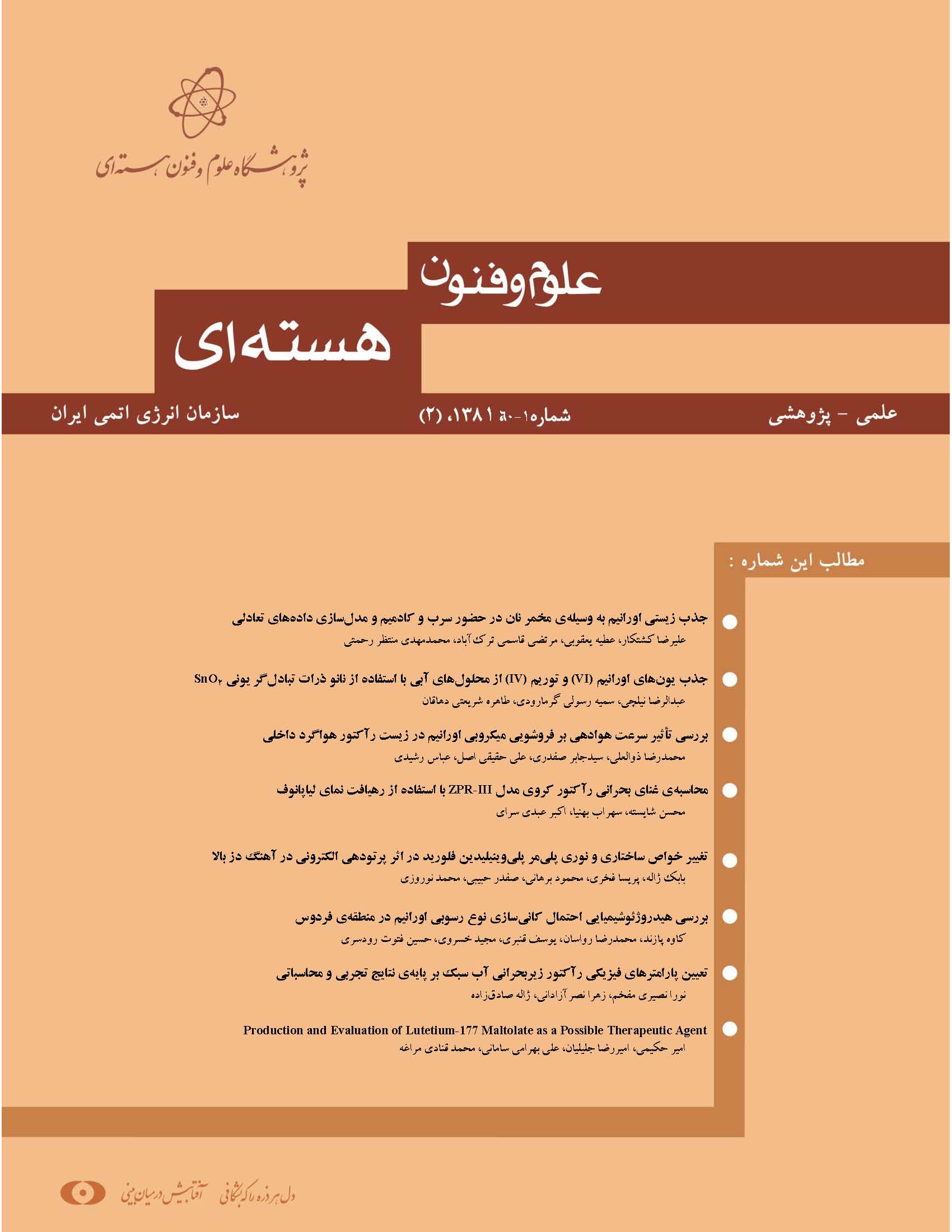نوع مقاله : مقاله پژوهشی
نویسندگان
1 دانشکده مهندسی شیمی، دانشگاه سمنان، صندوق پستی: 3513119111، سمنان ـ ایران
2 پژوهشگاه علوم و فنون هستهای، سازمان انرژی اتمی ایران، صندوق پستی: 836-14395، تهران ـ ایران
چکیده
فروشویی میکروبی اورانیم از سنگ معدن اورانیم آنومالی 2 ساغند به وسیلهی باکتری اسیدی تیوباسیلوس فرواکسیدان در زیست رآکتور هواگرد داخلی با هدف بررسی تأثیر سرعت هوادهی بر آن و یافتن مقدار بهینهی آن صورت گرفت. آزمایشها در چهار سرعت هوادهی مختلف برای به دست آوردن بهترین نتیجهی بازیابی در کمترین زمان ممکن انجام گرفته است. نتایج نشان داد که بالاترین درصد بازیابی اورانیم در سرعت ظاهری m/s 0.010 بود که در مدت 11 روز به بالای %95 رسید. همچنین بهترین بازه برای مطالعهی هوادهی در زیسترآکتور هواگرد داخلی تعیین گردید. پایینترین مقدار این بازه، m/s 0.0065 بود که همان سرعت بحرانی تعلیق ذرات اورانیم و بالاترین مقدار آن m/s 0.015 بود. در سرعتهای بالاتر از m/s 0.015 تنش وارد بر باکتری زمان فرایند استخراج را افزایش میدهد.
کلیدواژهها
عنوان مقاله [English]
Investigation of Aeration Rate on Uranium Bioleaching in Internal Airlift Bioreactor
نویسندگان [English]
- M.R Zolala 1
- S.J Safdari 2
- A Haghighi Asl 1
- A Rashidi 2
چکیده [English]
Uranium is leached from the uranium ore of the second anomaly of Saghand by the Acidithiobacillus ferrooxidans bacteria in an internal airlift bio-reactor. This study has been made to find the effect of aeration rate as well as its optimal value. The experiments have been carried out at 4 aeration rates to find the best recovery results in the least possible time duration. The results showed that the most percentage of the uranium recovery is in the superficial gas velocity of 0.010 m/s. The recovery at this aeration rate has an efficiency of more than 95% in 11 days. Also, the best range for aeration study in the airlift bio-reactor is calculated with a minimum value of 0.0065 m/s which is the critical value of the uranium particle suspension as well as the maximum value of 0.015 m/s. The stress on the bacteria increases the recovery time process in velocities of more than 0.015 m/s.
کلیدواژهها [English]
- Bioleaching
- Uranium Ores
- Thiobacillus Ferrooxidans
- Bioreactors
- Aeration Rate
- Saghand
-
A. Rubio, F.G. Garcia, “Bioleaching capacity of an extremely thermophile culture for chalcopyritic materials,” Minerals Engineering 15, 689-694 (2002).
-
M.A. Jordan, S.M.C. Guiness, C.V. Philips, “Acidophilic bacteria their potential mining and environmental applications,” Minerals Engineering 9 (2), 169-181 (1996).
-
A.D. Agate, “Recent advances in microbial mining,” World Journal of Microbiology and Biotechnology 12, 487-495 (1996).
-
J.A. Munoz, F. Gonzalez, M.L. Blazquez, A. Ballester, “Study of the bioleaching of a Spanish uranium ore, Part I: a review of the bacterial leaching in the treatment of uranium ores,” Hydrometallurgy 38, 39-57 (1995).
-
W. Krebs, C. Brombacher, P.P. Bosshard, R. Bachofen, H. Brandl, “Microbial recovery of metals from solids,” FEMS Microbiology Reviews 20, 605-617 (1997).
-
D.E. Rawlings, “Industrial practice and the biology of leaching of metals from ores,” Journal of Industrial Microbiology and Biotechnology 20, 268-274 (1998).
-
Abhilash, S. Singh, K.D. Mehta, V. Kumar, B.D. Pandey, V.M. Pandey, “Dissolution of uranium from silicate-apatite ore by Acidithiobacillus ferrooxidans,” Hydrometallurgy 95, 70-75 (2009).
-
P.R. Norris, D.W. Barr, D. Hinson, “Iron and mineral oxidation by acidophilic bacteria: affinities for iron and attachment to pyrite. In: P.R. Norris, D.P. Kelly, (Eds.), Biohydrometallurgy: Proc. Intl. Symposium (Warwick, UK),” Science and Technology Letters, Kew, 43-59 (1988).
-
G.S. Hansford, “Recent developments in modeling the kinetics of bioleaching. In: D.E. Rawlings, (Ed.), Biomining: Theory, Microbes and Industrial Processes,” Springer Verlag, Berlin, 153-175 (1997).
-
K.L. Temple, A.R. Colmer, “The autotrophic oxidation of iron by a new bacterium, Thiobacillus ferrooxidans,” J. Bacteriol 62, 605-611 (1951).
-
A.E. Torma, G.G. Gabra, “Oxidation of stibnite by Thiobacillus ferrooxidans,” Ant Leeuwenh 43, 1-6 (1997).
-
A. Akcil, H. Deveci, “Mineral Biotechnology of sulphides, In: Jain, S. Khan, A. Rai, M.K. (Eds.), Geomicrobiology,” Science Publishers, Enfield, New Hampshire, USA, 101-137 Chapter 4 (2010).
-
A.W. Breed, C.J.N. Dempers, G.S. Hansford, “Studies on the bioleaching of refractory concentrates,” J.S. AFR. Inst. Min. Metall. 100, 389-397 (2000).
-
J.A. Munoz, F. Gonzalez, M.L. Blasquez, A. Ballester, “A study of the bioleaching of a Spanish uranium ore, part I: a review of the bacterial leaching in the treatment of uranium ores,” Hydrometallurgy 38, 39-57 (1995).
-
Y. Chisti, U.J. Jauregui-Haza, “Oxygen transfer and mixing in mechanically agitated airlift bioreactors,” Biochem. Eng. J. 10, 143-153 (2002).
-
C. Vial, S. Poncin, G. Wild, N. Midoux, “Experimental and theoretical analysis of the hydrodynamics in the riser of an external loop airlift reactor,” Chem. Eng. Sci. 57, 4745-4762 (2002).
-
J.C. Merchuk, M. Gluz, Bioreactors, Airlift Reactors. In the Encyclopedia of Bioprocess Technology (M.C. Flickinger, S.W. Drew, editors). 1, 320-353, John Wiley & Sons Inc., USA (1999).
-
Y. Chisti, “Airlift Bioreactors,” Elsevier Applied Science, London (1989).
-
ع. رشیدی، س.ج. صفدری، ر. روستاآزاد، م.ف. فروغیان، ب. رفیعزاده، ح. زارع توکلی، ”جداسازی سویههای بومی اسیدیتیوباسیلیوس از معدن اورانیم و بررسی اثر آنها در بیولیچینگ اورانیم،“ دومین همایش ملی میکروبیولوژی کاربردی ایران، دانشگاه تهران (1389).
-
R.M. Atlas, “Handbook of media for environmental microbiology,” Second Edition, Taylor and Francis (2005).
-
ASTM, D4454 Standard test method for simulataneous enumeration of total and respiring in aquatic systems by microscopy, annual book of ASTM standards, American society for testing and materials, 11 (02) (2009).
-
S.P. Mehrotra and R. Shekhar, Particle Suspension in (Air-Agitated) Pachuca tanks: Investigation of Hysteresis and a novel split air injection technique, Metallurgical and Materials Transactions, 32B, 223-231 (2001).
A. Giaveno, L. Lavalle, P. Chiacchiarini, E. Donati, “Bioleaching of zinc from low-grade complex sulfide ores in an airlift by isolated Leptospirillum ferrooxidans,” Hydrometallurgy 89, 117–126 (2007).

